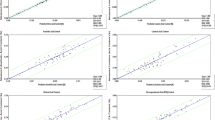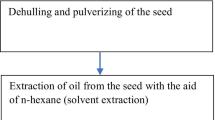Abstract
Inexpensive and rapid methods for measurement of seed oil content by near infrared reflectance spectroscopy (NIRS) are useful for developing new oil seed cultivars. Adopting default multiple linear regression (MLR), the predictions of safflower oil content were made by 20–140 samples using a Perten Inframatic 8620 NIR spectrometer. Although the obtained interpolation results of MLR had desired accuracy, the extrapolation was extremely poor. The extrapolation determination coefficient (R 2) and standard error (SE) of cross validation for MLR models were 0.63–0.78 and 3.71–4.44, respectively. In order to overcome the accuracy limitation of linear MLR models, a common suggestion is to use a nonlinear artificial neural network (ANN); however, it needs a large number of data to yield significant accurate results. We developed a novel robust hybrid fuzzy linear neural (HFLN) network to capture simultaneously linear and nonlinear patterns of data with a limited number of safflower samples. Empirical extrapolation results showed that the HFLN had higher R 2 (=0.85) and lower SE (=1.83) compared to those obtained by MLR and ANN models. It is concluded that hybrid methodologies could be used to construct efficient and appropriate models for estimation of seed oil content set up on NIR system.


Similar content being viewed by others
References
Cen H, He Y (2007) Theory and application of near infrared reflectance spectroscopy in determination of food quality. Trends Food Sci Tech 18:72–83
Rodriguez-Nogales JM (2006) Approach to the quantification of milk mixtures by partial least-squares, principal component and multiple linear regression techniques. Food Chem 98:782–789
Velasco L, Becker HC (1998) Estimating the fatty acid composition of the oil in intact-seed rapeseed (Brassica napus L.) by near-infrared reflectance spectroscopy. Euphytica 101:221–230
Perez-Vich B, Velasco L, Fernandez-Martınez JM (1998) Determination of seed oil content and fatty acid composition in sunflower through the analysis of intact seeds, husked seeds, meal and oil by near-infrared reflectance spectroscopy. J Am Oil Chem Soc 75:547–555
Tillman BL, Gorbet DW, Person G (2006) Predicting oleic and linoleic acid content of single peanut seeds using near-infrared reflectance spectroscopy. Crop Sci 46:2121–2126
Igne B, Rippke GR, Hurburgh CR (2008) Measurement of whole soybean fatty acids by near infrared spectroscopy. J Am Oil Chem Soc 85:1105–1113
Nimaiyar S, Paulsen MR, Nelson RL (2004) Rapid analysis of fatty acids in soybeans using FT-NIR. Paper number 046118, ASAE/CSAE Annual International Meeting, Ottawa, ON, Canada
Kovalenko IV, Rippke GR, Hurburgh CR (2006) Measurement of soybean fatty acids by near-infrared spectroscopy: linear and nonlinear calibration methods. J Am Oil Chem Soc 83:421–427
Jensen RR, Karki S, Salehfar H (2004) Artificial neural network-based estimation of mercury speciation in combustion flue gases. Fuel Process Technol 85:451–462
Sabzalian MR, Saeidi G, Mirlohi A (2008) Oil content and fatty acid composition in seeds of three safflower species. J Am Oil Chem Soc 85:717–721
Rudolphi S, von Witzke-Ehbrecht S, Becker HC (2005) Estimation of oil content in safflower by near infrared reflectance spectroscopy. In: Esendal E (ed) A unique crop for oil, spices and health, consequently a better life for you. Proceedings of the 6th International Safflower Conf, Istanbul, 6–10 June, Turkey, pp 344–347.
Elfadl E, Reinbrecht C, Claupein W (2010) Evaluation of phenotypic variation in a worldwide germplasm collection of safflower (Carthamus tinctorius L.) grown under organic farming conditions in Germany. Genet Resour Crop Evol 57:155–170
AOCS (1993) Official methods and recommended practices. The American Oil Chemists' Society, Champaign, IL
Naes T, Isakson T, Fearn T, Davies T (2002) Multivariate calibration and classification. NIR Publications, Chichester, UK
Khashei M, Bijari M (2010) An artificial neural network (p, d, q) model for time series forecasting. Expert Syst Appl 37:479–489
Khashei M, Bijari M (2011) A novel hybridization of artificial neural networks and ARIMA models for time series forecasting. Appl Soft Comput 11:2664–2675
Khashei M, Bijari M, Raissi GH (2009) Improvement of auto-regressive integrated moving average models using fuzzy logic and artificial neural networks (ANNs). Neurocomputing 72:956–967
Inon FA, Garrigues S, de la Guardia M (2006) Combination of mid-and near-infrared spectroscopy for the determination of the quality properties of beers. Anal Chim Acta 571:167–174
Blanco M, Pages J (2002) Classification and quantitation of finishing oils by near infrared spectroscopy. Anal Chim Acta 463:295–303
Basheer IA, Hajmeer M (2000) Artificial neural networks: fundamentals, computing, design, and application. J Microbiol Methods 43:3–31
Khashei M, Hejazi SR, Bijari M (2008) A new hybrid artificial neural networks and fuzzy regression model for time series forecasting. Fuzzy Sets Syst 159:769–786
Acknowledgments
The authors would like to thank Miss Somayeh Khosravi, M.K.S. International Corp., for her collaboration in MLR mathematical modeling with PICS software and Mr. Amin Niroomanesh for his assistance in data management.
Author information
Authors and Affiliations
Corresponding author
About this article
Cite this article
Sabzalian, M.R., Khashei, M. & Ghaderian, M. Artificial and Hybrid Fuzzy Linear Neural Network-Based Estimation of Seed Oil Content of Safflower. J Am Oil Chem Soc 91, 2091–2099 (2014). https://doi.org/10.1007/s11746-014-2547-6
Received:
Revised:
Accepted:
Published:
Issue Date:
DOI: https://doi.org/10.1007/s11746-014-2547-6




